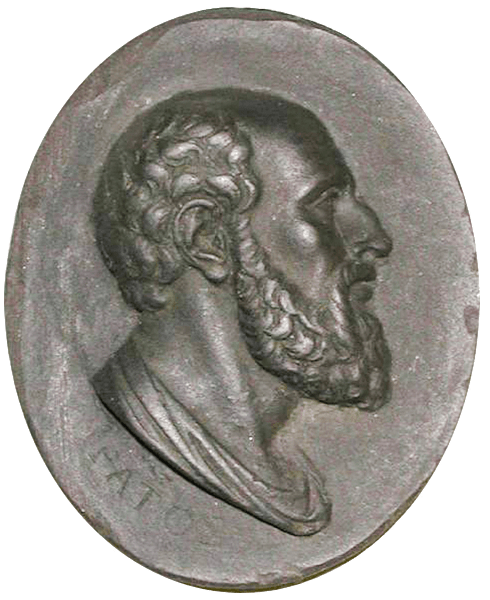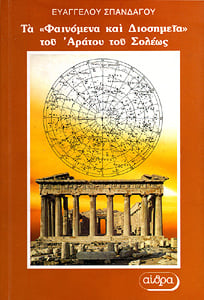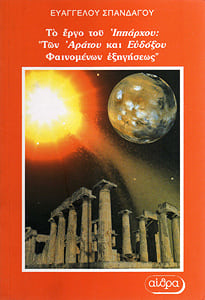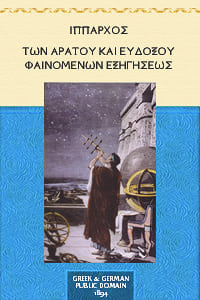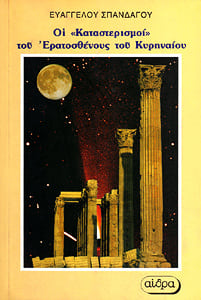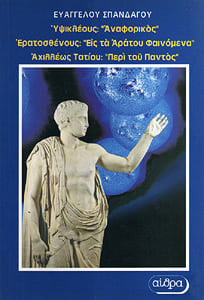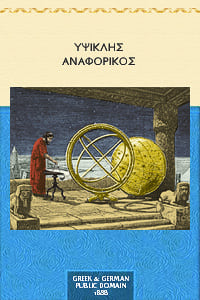
ΑΣΤΕΡΙΣΜΩΝ ΣΥΝΑΝΑΤΟΛΑΙ ΚΑΙ ΣΥΓΚΑΤΑΔΥΣΕΙΣ, ΣΤΙΧΟΙ 451 – 732
ἑλληνικὸ πρωτότυπο μὲ ἀγγλικὴ μετάφραση, τῶν Mair, A. W. & G. R., Κλασικὴ Βιβλιοθήκη Loeb, Λονδίνο, 1921
μὲ σχόλια Θέωνος Ἀλεξανδρέως
❧
Ταῦτά κε θηήσαιο παρερχομένων ἐνιαυτῶν
ἑξείης παλίνωρα· τὰ γὰρ καὶ πάντα μάλ’ αὕτως
οὐρανῷ εὖ ἐνάρηρεν ἀγάλματα νυκτὸς ἰούσης.
Οἱ δ’ ἐπιμὶξ ἄλλοι πέντ’ ἀστέρες οὐδὲν ὁμοῖοι 34
455 πάντοθεν εἰδώλων δυοκαίδεκα δινεύονται.
Οὐκ ἂν ἔτ’ εἰς ἄλλους ὁρόων ἐπιτεκμήραιο
κείνων ἧχι κέονται, ἐπεὶ πάντες μετανάσται,
μακροὶ δὲ σφεών εἰσιν ἑλισσομένων ἐνιαυτοί,
μακρὰ δὲ σήματα κεῖται ἀπόπροθεν εἰς ἓν ἰόντων,
460 οὐδ’ ἔτι θαρσαλέος κείνων ἐγώ· ἄρκιος εἴην
ἀπλανέων τά τε κύκλα τά τ’ αἰθέρι σήματ’ ἐνισπεῖν.
Ἤτοι μὲν τά γε κεῖται ἀλίγκια δινωτοῖσιν 35,
τέσσαρα, τῶν κε μάλιστα ποθὴ ὄφελός τε γένοιτο
μέτρα περισκοπέοντι κατανομένων ἐνιαυτῶν.
465 Σήματα δ’ εὖ μάλα πᾶσιν ἐπιρρήδην περίκειται
πολλά τε καὶ σχεδόθεν πάντη συνεεργμένα πάντα,
αὐτοὶ δ’ ἀπλατέες καὶ ἀρηρότες ἀλλήλοισιν
πάντες, ἀτὰρ μέτρῳ γε δύω δυσὶν ἀντιφέρονται.
Εἴ ποτέ τοι νυκτὸς καθαρῆς, ὅτε πάντας ἀγαυοὺς
470 ἀστέρας ἀνθρώποις ἐπιδείκνυται οὐρανίη Νύξ,
οὐδέ τις ἀδρανέων φέρεται διχόμηνι σελήνῃ,
ἀλλὰ τά γε κνέφαος διαφαίνεται ὀξέα πάντα,
εἴ ποτέ τοι τημόσδε περὶ φρένας ἵκετο θαῦμα
σκεψαμένῳ πάντη κεκεασμένον εὐρέι κύκλῳ
475 οὐρανόν, ἢ καί τίς τοι ἐπιστὰς ἄλλος ἔδειξεν
κεῖνο περιγληνὲς τροχαλόν (Γάλα μιν καλέουσιν),
τῷ δ’ ἤτοι χροιὴν μὲν ἀλίγκιος οὐκέτι κύκλος 36
δινεῖται, τὰ δὲ μέτρα τόσοι πισύρων περ ἐόντων
οἱ δύο, τοὶ δέ σφεων μέγα μείονες εἱλίσσονται.
All these constellations thou canst mark as the seasons pass, each returning at its appointed time: for all are unchangingly and firmly fixed in the heavens to be the ornaments of the passing night. But of quite a different class are those five other orbs, that intermingle with them and wheel wandering on every side of the twelve figures of the Zodiac. No longer with the others as they guide couldst thou mark where lies the path of those, since all pursue a shifty course, and long are the periods of their revolution and far distant lies the goal of their conjunction. When I come to them my daring fails, but mine be the power to tell of the orbits of the Fixed Stars and Signs in heaven. These orbits lie like rings, four in number, chief in interest and in profit, if thou wouldst mark the measures of the waning and the waxing of the Seasons. On all are set beacon lights, many in number, all every way closely penned together. The circles are immovable, and fitted each to other, but in size two are matched with two. If ever on a clear night, when Night in the heavens shows to men all her stars in their brightness and no star is borne faintly gleaming at the mid-month moon, but they all sharply pierce the darkness – if in such an hour wonder rises in thy heart to mark on every side the heaven cleft by a broad belt, or if someone at they side point out that circle set with brilliants – that is what men call the Milky Way. A match for it in colour thou wilt find no circle wheel, but in size two of the four belts as large, but the other two are far inferior.
480 Τῶν ὁ μὲν ἐγγύθεν ἐστὶ κατερχομένου βορέαο.
Ἐν δέ οἱ ἀμφότεραι κεφαλαὶ Διδύμων φορέονται,
ἐν δέ τε γούνατα κεῖται ἀρηρότος Ἡνιόχοιο,
λαιὴ δὲ κνήμη καὶ ἀριστερὸς ὦμος ἐπ’ αὐτῷ
Περσέος, Ἀνδρομέδης δὲ μέσην ἀγκῶνος ὕπερθεν
485 δεξιτερὴν ἐπέχει· τὸ μέν οἱ θέναρ ὑψόθι κεῖται
ἀσσότερον βορέαο, νότῳ δ’ ἐπικέκλιται ἀγκών.
Ὁπλαὶ δ’ Ἵππειοι, καὶ ὑπαύχενον Ὀρνίθειον
ἄκρῃ σὺν κεφαλῇ, καλοί τ’ Ὀφιούχεοι ὦμοι
αὐτὸν δινεύονται ἐληλάμενοι περὶ κύκλον,
490 ἡ δ’ ὀλίγον φέρεται νοτιωτέρη, οὐδ’ ἐπιβάλλει,
Παρθένος, ἀλλὰ Λέων καὶ Καρκίνος· οἱ μὲν ἅμ’ ἄμφω
ἑξείης κέαται βεβλημένοι, αὐτὰρ ὁ κύκλος
τὸν μὲν ὑπὸ στῆθος καὶ γαστέρα μέχρι παρ’ αἰδῶ
τέμνει, τὸν δὲ διηνεκέως ὑπένερθε χελείου
495 Καρκίνον, ἧχι μάλιστα διχαιόμενόν κε νοήσαις
ὀφθόν, ἵν’ ὀφθαλμοὶ κύκλου ἑκάτερθεν ἴοιεν.
Τοῦ μὲν ὅσον τε μάλιστα δι’ ὀκτὼ μετρηθέντος
πέντε μὲν ἔνδια στρέφεται καθ’ ὑπέρτερα γαίης 37,
τὰ τρία δ’ ἐν περάτῃ, θέρεος δέ οἱ ἐν τροπαί εἰσιν.
500 Ἀλλ’ ὁ μὲν ἐν βορέω περὶ Καρκίνον ἐστήρικται.
Of the lesser circles one [Summer Tropic] is night to Boreas at his coming, and on it are borne both the heads of the Twins and the knees of the stedfast Charioteer, and above him are the left shoulder and shin of Perseus. It crosses Andromeda’s right arm above the elbow. Above it is set her palm, nearer the north, and southward leans her elbow. The hoofs of the Horse, the head and neck of the Bird and Ophiuchus’ bright shoulders wheel along this circle in their course. The Maiden is borne a little to the South and does not touch the Belt, but on it are the Lion and the Crab, Thereon are they both established side by side, but the circle cuts the Lion beneath the breast and belly lengthwise to the loins, and the Crab it cuts clean through by the shell where thou canst see him most clearly cut, as he stands upright with his eyes on either side of the Belt. The circle is divided, as well as may be, into eight parts, whereof five in the daytime wheel on high above the earth and three beneath the horizon. In it is the Turning-point of the Sun in summer. This circle is set round the Crab in the North.
Ἄλλος δ’ ἀντιόωντι νότῳ μέσον Αἰγοκερῆα
τέμνει καὶ πόδας Ὑδροχόου καὶ Κήτεος οὐρήν·
ἐν δέ οἵ ἐστι Λαγωός, ἀτὰρ Κυνὸς οὐ μάλα πολλὴν
αἴνυται, ἀλλ’ ὁπόσην ἐπέχει ποσίν· ἐν δέ οἱ Ἀργὼ
505 καὶ μέγα Κενταύροιο μετάφρενον, ἐν δέ τε κέντρον
Σκορπίου, ἐν καὶ τόξον ἐλαφροῦ Τοξευτῆρος.
Τὸν πύματον καθαροῖο παρερχόμενος βορέαο
ἐς νότον ἠέλιος φέρεται, τρέπεταί γε μὲν αὐτοῦ
χειμέριος, καί οἱ τρία μὲν περιτέλλεται ὑψοῦ
510 τῶν ὀκτώ, τὰ δὲ πέντε κατώρυχα δινεύονται.
Μεσσόθι δ’ ἀμφοτέρων, ὅσσος πολιοῖο Γάλακτος,
γαῖαν ὑποστρέφεται κύκλος διχόωντι ἐοικώς,
ἐν δέ οἱ ἤματα νυξὶν ἰσαίεται ἀμφοτέρῃσιν,
φθίνοντος θέρεος, τοτὲ δ’ εἴαρος ἱσταμένοιο.
515 Σῆμα δέ οἱ Κριὸς Ταύροιό τε γούνατα κεῖται,
Κριὸς μὲν κατὰ μῆκος ἐληλάμενος διὰ κύκλου,
Ταύρου δὲ σκελέων ὅσση περιφαίνεται ὀκλάς.
Ἐν δέ τέ οἱ ζήνη εὐφεγγέος Ὠρίωνος
καμπή τ’ αἰθομένης Ὕδρης· ἐνί οἱ καὶ ἐλαφρὸς
520 Κρητήρ, ἐν δὲ Κόραξ, ἐνὶ δ’ ἀστέρες οὐ μάλα πολλοὶ
Χηλάων, ἐν τῷ δ’ Ὀφιούχεα γοῦνα φορεῖται.
Οὐ μὴν Αἰητοῦ ἀπαμείρεται, ἀλλά οἱ ἐγγὺς
Ζηνὸς ἀητεῖται μέγας ἄγγελος· ἡ δὲ κατ’ αὐτὸν
Ἱππείη κεφαλὴ καὶ ὑπαύχενον εἱλίσσονται.
But there is another circle [Winter Tropic] to match in the South. It cuts through the middle of Aegoceros, the feet of Hydrochoüs, and the tail of the sea-monster, Cetus, and on it is the Hare. It claims no great share of the Dog, but only the space that he occupies with his feet. In it is Argo and the mighty back of the Centaur, the sting of Scorpio, and the Bow of the bright Archer. This circle the sun passes last as he is southward borne from the bright north, and here is the Turning-point of the sun in winter. Three parts of eight of his course are above and five below the horizon. Between the Tropics a Belt [the Equator], peer of the grey Milky Way, undergirds the earth with imaginary line bisects the sphere. In it the days are equal to the nights both at the waning of the summer and the waxing of the spring [the Equinoxes]. The sign appointed for it is the Ram and the knees of the Bull – the Ram being borne lengthwise through it, but of the Bull just the visible bend of the knees. In it are the Belt of the well-starred Orion and the coil of the gleaming Hydra: in it, too, the dim-lit Crater and the Crow and the scanty-starred Claws and the knees of Ophiuchus are borne. But it has no share in the Eagle, but near it flies the mighty messenger of Zeus. Facing the Eagle wheel the head and neck of the Horse.
525 Τοὺς μὲν παρβολάδην ὀρθοὺς περιβάλλεται ἄξων,
μεσσόθι πάντας ἔχων, ὁ δὲ τέτρατος ἐσφήκωται
λοξὸς ἐν ἀμφοτέροις, οἵ μὲν ῥ’ ἑκάτερθεν ἔχουσιν
ἀντιπέρην τροπικοί, μέσσος δὲ ἐν μεσσόθι τέμνει.
Οὔκ ἂν Ἀθηναίης χειρῶν δεδιδαγμένος ἀνὴρ
530 ἄλλῃ κολλήσαιτο κυλινδόμενα τροχάλεια
τοῖά τε καὶ τόσα πάντα περὶ σφαιρηδὸν ἑλίσσων·
ὣς τά γ’ ἐν αἰθέριᾳ πλαγίῳ συναρηρότα κύκλῳ
ἐξ ἠοῦς ἐπὶ νύκτα διώκεται ἤματα πάντα.
Καὶ τὰ μὲν ἀντέλλει τε καὶ αὐτίκα νειόθι δύνει
535 πάντα παραβλήδην, μία δέ σφεων ἐστὶν ἑκάστου
ἑξείης ἑκάτερθε κατηλυσίη ἄνοδός τε·
αὐτὰρ ὅ γ’ ὠκεανοῦ τόσσον παραμείβεται ὕδωρ
ὅσσον ἀπ’ Αἰγοκερῆος ἀνερχομένοιο μάλιστα
Καρκίνον εἰς ἀνιόντα κυλίνδεται. ὅσσον ἁπάντη
540 ἀντέλλων ἐπέχει, τόσσον γε μὲν ἄλλοθι δύνων·
ὅσσον δ’ ὀφθαλμοῖο βολῆς ἀποτείνεται αὐγή 38,
ἑξάκις ἂν τόσση μιν ὑποδράμοι· αὐτὰρ ἑκάστη
ἴση μετρηθεῖσα δύω περιτέμνεται ἄστρα.
Ζῳδίων δέ ἑ κύκλον ἐπίκλησιν καλέουσι.
These three Belts [Two Tropics, Equator] are parallel, and at right angles to the Axis which they surround and which is the centre of them all, but the fourth [Ecliptic] aslant is fixed athwart the Tropics: they on opposite sides of the Equator support it at either limit, but the Equator bisects it. Not otherwise would a man skilled in the handicraft of Athena join the whirling Belts, wheeling them all around, so many and so great like rings, just as the Belts in the heavens, clasped by the transverse circle, hasten from dawn to night throughout all time. The three Belts rise and set all parallel but ever single and the same is the pint where in due order each rises or sets at East or West. But the fourth circle passes over as much water of ocean as rolls between the rising Aegoceros, and the rising of the Crab: as much as it occupies in rising, so much it occupies in setting. As long as is the ray cast to heaven from the glance of the eye, six times as long a line would subtend this Belt. Each ray, measured of equal length, intercepts the two constellations. This circle is called the Belt of the Zodiac.
545 Τῷ ἔνι Καρκίνος ἐστί, Λέων δ’ ἐπὶ τῷ, καὶ ὑπ’ αὐτὸν
Παρθένος, αἱ δ’ ἐπί οἱ Χηλαὶ καὶ Σκορπίος αὐτὸς
Τοξευτής τε καὶ Αἰγόκερως, ἐπὶ δ’ Αἰγοκερῆϊ
Ὑδροχόος, δύο δ’ αὐτῷ ἐπ’ Ἰχθύες ἀστερόεντες,
τοὺς δὲ μέτα Κριός, Ταῦρος δ’ ἐπὶ τῷ Δίδυμοί τε.
550 Ἐν τοῖς ἠέλιος φέρεται δυοκαίδεκα πᾶσιν
πάντ’ ἐνιαυτὸν ἄγων, καί οἱ περὶ τοῦτον ἰόντι
κύκλον ἀέξονται πᾶσαι ἐπικάρπιοι ὧραι.
Τοῦ δ’ ὅσσον κοίλοιο κατ’ ὠκεανοῖο δύηται 39,
τόσσον ὑπὲρ γαίης φέρεται, πάσῃ δ’ ἐπὶ νυκτὶ
555 ἓξ αἰεὶ δύνουσι δυωδεκάδες κύκλοιο 40,
τόσσαι δ’ ἀντέλλουσι· τόσον δ’ ἐπὶ μῆκος ἑκάστη 41
νὺξ αἰεὶ τετάνυσται, ὅσον τέ περ ἥμισυ κύκλου
ἀρχομένης ἀπὸ νυκτὸς ἀείρεται ὑψόθι γαίης.
Οὔ κεν ἀπόβλητον δεδοκημένῳ ἤματος εἴη
560 μοιράων σκέπτεσθαι ὅτ’ ἀντέλλῃσιν ἑκάστη·
αἰεὶ γὰρ τάων γε μιῇ συνανέρχεται αὐτὸς
ἠέλιος. Τας δ’ ἄν κε περισκέψαιο μάλιστα
εἰς αὐτὰς ὁρόων, ἀτὰρ εἰ νεφέεσσι μέλαιναι
γίνοιντ’ ἢ ὄρεος κεκρυμμέναι ἀντέλλοιεν,
565 σήματ’ ἐπερχομένῃσιν ἀρηρότα ποιήσασθαι.
Αὐτὸς δ’ ἂν μάλα τοι κεράων ἑκάτερθε διδοίη
ὠκεανὸς τά τε πολλὰ περιστέφεται ἑοῖ αὐτῷ
νειόθεν ὁππῆμος κείνων φορέῃσιν ἑκάστην.
In it is the Crab; after the Crab the Lion and beneath him the Maiden; after the Maiden the Claws and the Scorpion himself and the Archer and Aegoceros, and after Aegoceros Hydrochoüs. Beneath him are enstarred the Two Fishes and after them the Ram and next the Bull and the Twins. In them, twelve in all, has the sun his course as he leads on the whole year, and as he fares around this belt, all the fruitful seasons have their growth. Half this Belt is set below the hollow of the horizon, and half is above the earth. Every night six constellations of this circle’s twelve set and as many rise; as long is each night ever stretched as half the belt rises above the earth from the fall of night. Not useless were it for one who seeks the signs of coming day to mark when each sign of the Zodiac rises. For ever with one of them the sun himself rises. One could best search out those constellations by looking on themselves, but if they be dark with clouds or rise hidden behind a hill, get thee fixed signs for their coming. Ocean himself will give thee signs at either horn – the East or the West – in the many constellations that wheel about him, when from below he sends forth each rising sign.
Οὔ οἱ ἀφαυρότατοι, ὅτε Καρκίνος ἀντέλλῃσιν,
570 ἀστέρες ἀμφοτέρωθεν ἑλισσόμενοι περίκεινται 42,
τοὶ μὲν δύνοντες, τοὶ δ’ ἐξ ἑτέρης ἀνιόντες.
Δύνει μὲν Στέφανος, δύνει δὲ κατὰ ῥάχιν Ἰχθῦς·
ἥμισυ μέν κεν ἴδοιο μετήορον, ἥμισυ δ’ ἤδη
ἐσχατιαὶ βάλλουσι κατερχομένου Στεφάνοιο.
575 Αὐτὰρ ὅ γ’ ἐξόπιθεν τετραμμένος ἄλλα μὲν οὔπω
γαστέρι νειαίρῃ, τὰ δ’ ὑπέρτερα νυκτὶ φορεῖται.
Τὸν δὲ καὶ εἰς ὤμους κατάγει μογερὸν Ὀφιοῦχον
Καρκίνος ἐκ γονάτων, κατάγει δ’ Ὄφιν αὐχένος ἐγγύς.
Οὐδ’ ἂν ἔτ’ Ἀρκτοφύλαξ εἴη πολὺς ἀμφοτέρωθεν,
580 μείων ἠμάτιος, τὸ δ’ ἐπὶ πλέον ἔννυχος ἤδη.
Τέτρασι γὰρ μοίραις ἄμυδις κατιόντα Βοώτην
ὠκεανὸς δέχεται· ὁ δ’ ἐπὴν φάεος κορέσηται,
βουλυτῷ ἐπέχει πλεῖον δίχα νυκτὸς ἰούσης,
ἦμος ὅτ’ ἠελίοιο κατερχομένοιο δύηται.
585 Κεῖναι οἱ καὶ νύκτες ἐπ’ ὀψὲ δύοντι λέγονται.
Ὡς οἱ μὲν δύνουσιν, ὁ δ’ ἀντίος οὐδὲν ἀεικής,
ἀλλ’ εὖ μὲν ζώνῃ, εὖ δ’ ἀμφοτέροισι φαεινὸς
ὤμοις Ὠρίων, ξίφεός γε μὲν ἶφι πεποιθώς,
πάντα φέρων Ποταμόν, κέραος παρατείνεται ἄλλου.
When the Crab [Cancer] rises, not very faint are the wheeling constellations that are set about Ocean at East and West, some setting in the West and other rising in the East. The Corwn sets and the Southern Fish as far as its back. Half the setting Crown is visible in the sky but half already sinks beneath the verge. Of the Phantom, backward turned, the waist is still visible but his upper parts are borne in night. The rise of the Crab brings down from knee to shoulder the wretches Ophiuchus and Ophis to the neck. No longer great on both sides of the horizon is Arctophylax but only the lesser portion is visible, while the greater part is wrapt in night. For with four signs of the Zodiac Boötes sets and is received in the bosom of ocean; and when he is sated with the light he takes till past midnight in the loosing of this oxen, in the season when he sets with the sinking sun. Those nights are named after his late setting. So these stars are setting, but another, facing them, no dim star, even Orion with glittering belt and shining shoulders and trusting in the might of his sword, and brining all the River, rises from the other horn, the East.
590 Ἐρχομένῳ δὲ Λέοντι τὰ μὲν κατὰ πάντα φέρονται
Καρκίνῳ ὅσσ’ ἐδύοντο, καὶ Αἰετός. Αὐτὰρ ὅ γε γνὺξ
ἥμενος ἄλλα μὲν ἤδη, ἀτὰρ γονὺ καὶ πόδα λαιὸν
οὔπω κυμαίνοντος ὑποστρέφει ὠκεανοῖο.
Ἀντέλλει δ’ Ὕδρης κεφαλὴ χαροπός τε Λαγωὸς
595 καὶ Προκύων πρότεροί τε πόδες Κυνὸς αἰθομένοιο.
Οὐ μέν θην ὀλίγους γαίης ὑπὸ νείατα βάλλει
Παρθένος ἀντέλλουσα. Λύρη τότε Κυλληναίη
καὶ Δελφὶς δύνουσι καὶ εὐποίητος Ὀϊστός.
Σὺν τοῖς Ὄρνιθος πρῶτα πτερὰ μέσφα παρ’ αὐτὴν
600 οὐρὴν καὶ Ποταμοῖο παρηορίαι σκιόωνται.
Δύνει δ’ Ἱππείη κεφαλή, δύνει δὲ καὶ αὐχήν.
ἀντέλλει δ’ Ὕδρη μὲν ἐπὶ πλέον ἄχρι παρ’ αὐτὸν
Κρητῆρα, φθάμενος δὲ Κύων πόδας αἴνυται ἄλλους,
ἕλκων ἐξόπιθεν πρύμναν πολυτειρέος Ἀργοῦς,
605 ἡ δὲ θέει γαίης ἱστὸν διχόωσα κατ’ αὐτόν,
Παρθένος ἦμος ἅπασα περαιόθεν ἄρτι γένηται.
Οὐδ’ ἂν ἐπερχόμεναι Χηλαί, καὶ λεπτὰ φάουσαι 43,
ἄφραστοι παρίοιεν, ἐπεὶ μέγα σῆμα Βοώτης
ἀθρόος ἀντέλλει βεβολημένος Ἀρκτούροιο.
At the coming of the Lion [Leo] those constellations wholly set, which were setting when the Crab rose, and with them sets the Eagle. But the Phantom On His Knees winks all save knee and left foot beneath the stormy ocean. Up rises the Hydra’s head and the bright-eyed Hare and Procyon and the forefeet of the flaming Dog. Not few, either, are the constellations which the Maiden [Virgo] at her rising sends beneath the verge of the earth. Then set the Cyllenian Lyre, the Dolphin and the shapely Arrow. With them the wing-tips of the Bird up to her very tail and the farthest reaches of the River are overshadowed. The head of the Horse sets, sets too his neck. The Hydra rises higher as far as Crater, and before her the Dog brings up his hind feet, dragging behind him the stern of Argo of many stars. And she rises above earth, cleft right at the mast, just when the whole of the Maiden has risen. Nor can the rising Claws [Libra], though faintly shining, pass unremarked, when at a bound the mighty sign of Boötes rises, jeweled with Arcturus.
610 Ἀργὼ δ’ εὖ μάλα πᾶσα μετήορος ἵσταται ἤδη.
Ἀλλ’ Ὕδρη, κέχυται γὰρ ἐν οὐρανῷ ἤλιθα πολλή,
οὐρῆς ἂν δεύοιτο. Μόνην δ’ ἐπὶ Χηλαὶ ἄγουσι
[δεινὸν ἐφεστηῶτ’ Ὀφιούχεα· τοῦ μὲν ἔπειτα]
δεξιτερὴν κνήμην, αὐτῆς ἐπιγουνίδος ἄχρις,
615 αἰεὶ γνύξ, αἰεὶ δὲ Λύρη παραπεπτηῶτος,
ὅντινα τοῦτον ἄϊστον ὑπουρανίων εἰδώλων
ἀμφότερον δύνοντα καὶ ἐξ ἑτέρης ἀνιόντα
πολλάκις αὐτονυχεὶ θηεύμεθα. Τοῦ μὲν ἄρ’ οἴη
κνήμη σὺν Χηλῇσι φαείνεται ἀμφοτέρῃσιν 44,
620 αὐτὸς δ’ ἐς κεφαλὴν ἔτι που τετραμμένος ἄλλῃ
Σκορπίον ἀντέλλοντα μένει καὶ ῥύτορα Τόξου·
οἳ γάρ μιν φορέουσιν, ὁ μὲν μέσον ἄλλα τε πάντα,
χεῖρα δέ οἱ σκαιὴν κεφαλῇ ἅμα Τόξον ἀγινεῖ·
ἀλλ’ ὁ μὲν ὣς τρίχα πάντα καταμελεϊστὶ φορεῖται.
625 Ἥμισυ δὲ Στεφάνοιο καὶ αὐτὴν ἔσχατον οὐρὴν
Κενταύρου φορέουσιν ἀνερχόμεναι ἔτι Χηλαί.
Τῆμος ἀποιχομένην κεφαλὴν μέτα δύεται Ἵππος,
καὶ προτέρου Ὄρνιθος ἐφέλκεται ἔσχατος οὐρή.
Δύνει δ’ Ἀνδρομέδης κεφαλή, τὸ δέ οἱ μέγα δεῖμα
630 Κήτεος ἠερόεις ἐπάγει νότος, ἀντία δ’ αὐτὸς
Κηφεὺς ἐκ βορέω μεγάλῃ ἀνὰ χειρὶ κελεύει.
Καὶ τὸ μὲν ἐς λοφιὴν τετραμμένον ἄχρι παρ’ αὐτὴν
δύνει, ἀτὰρ Κηφεὺς κεφαλῇ καὶ χειρὶ καὶ ὤμῳ.
Καμπαὶ δ’ ἂν Ποταμοῖο καὶ αὐτίκ’ ἐπερχομένοιο
635 Σκορπίου ἐμπίπτοιεν ἐϋρρόου ὠκεανοῖο·
ὃς καὶ ἐπερχόμενος φοβέει μέγαν Ὠρίωνα.
Aloft is risen all of Argo, but the Hydra, shed as she is afar over the heavens, will lack her tail. The Claws bring only the right leg as far as the thigh of that Phantom that is ever On his Knees, ever crouching by the Lyre – that Phantom, unknown among the figures of the heavens, whom we often see both rise and set on the selfsame night. Of him only the leg is visible at the rising of both the Claws: he himself head-downward on the other side awaits the rising Scorpion and the Drawer of the Bow. For they bring him: Scorpion brings his waist and all aforesaid; the Bow his left hand and head. Even so in three portions is he all brought up piecemeal above the horizon. Half the Crown and the tip of the Centaur’s tail are upraised with the rising Claws. Then is the Horse setting after his vanished head, and dragged below is the tail-tip of the Bird, already set. The head of Andromeda is setting and against her is brought by the misty South the mighty terror, Cetus, but over against him in the North Cepheus with mighty hand upraised warns him back. Cetus, neck downward, sets to his neck, and Cepheus with head and hand and shoulder. The winding River will straightway sink in fair flowing ocean at the coming of Scorpion [Scorpio], whose rising puts to flight even the mighty Orion.
Ἄρτεμις ἱλήκοι· προτέρων λόγος, οἵ μιν ἔφαντο
ἑλκῆσαι πέπλοιο, Χίῳ ὅτε θηρία πάντα
καρτερὸς Ὠρίων στιβαρῇ ἐπέκοπτε κορύνῃ
640 θήρης ἀρνύμενος κείνῳ χάριν Οἰνοπίωνι.
Ἡ δέ οἱ ἐξαυτῆς ἐπετείλατο θηρίον ἄλλο,
νήσου ἀναρρήξασα μέσας ἑκάτερθε κολώνας,
σκορπίον, ὅς ῥά μιν οὖτα καὶ ἔκτανε πολλὸν ἐόντα
πλειότερος προφανείς, ἐπεὶ Ἄρτεμιν ἤκαχεν αὐτήν.
645 Τοὔνεκα δὴ καί φασι περαιόθεν ἐρχομένοιο
Σκορπίου Ὠρίωνα περὶ χθονὸς ἔσχατα φεύγειν.
Οὐδὲ μὲν Ἀνδρομέδης καὶ Κήτεος ὅσσ’ ἐλέλειπτο
κείνου ἔτ’ ἀντέλλοντος ἀπευθέες, ἀλλ’ ἄρα καὶ τοὶ
πανσυδίῃ φεύγουσιν, ὁ δὲ ζώνῃ τότε Κηφεὺς
650 γαῖαν ἐπιξύει, τὰ μὲν ἐς κεφαλὴν μάλα πάντα
βάπτων ὠκεανοῖο, τὰ δ’ οὐ θέμις, ἀλλὰ τά γ’ αὐταὶ
Ἄρκτοι κωλύουσι, πόδας καὶ γοῦνα καὶ ἰξύν.
Ἡ δὲ καὶ αὐτὴ παιδὸς ἐπείγεται εἰδώλοιο
δειλὴ Κασσιέπεια· τὰ δ’ οὐκέτι οἱ κατὰ κόσμον
655 φαίνεται ἐκ δίφροιο πόδες καὶ γούναθ’ ὕπερθεν,
ἀλλ’ ἥ γ’ ἐς κεφαλὴν ἴση δύετ’ ἀρνευτῆρι
μειρομένη γονάτων, ἐπεὶ οὐκ ἄρ’ ἔμελλεν ἐκείνη
Δωρίδι καὶ Πανόπῃ μεγάλων ἄτερ ἰσώσασθαι.
Thy pardon, Artemis, we crave! There is a tale told by the men of old, who said that stout Orion laid hands upon her robe, what time in Chios he was smiting with his strong club all manner of beasts, as a service of the hunt to that King Oenopion. But she forthwith rent in twain the surrounding hills of the island and roused up against him another kind of beast – even the Scorpion, who proving mightier wounded him, mighty though he was, and slew him, for that he had vexed Artemis. Wherefore, too, men say that at the rising of the Scorpion in the East Orion flees at the Western verge. Nor does what was left of Andromeda and of Cetus fail to mark his rise but in full career they too flee. In that hour the belt of Cepheus grazes earth as he dips his upper parts in the sea, but the rest he may not – his feet and knees and loins, for the Bears themselves forbid. The hapless Cassiepeia herself too hastes after the figure of her child. No longer in seemly wise does she shine upon her throne, feet and knees withal, but she headlong plunges like a diver, parted at the knees; for not scatheless was she to rival Doris and Panope.
Ἡ μὲν ἄρ’ εἰς ἑτέρην φέρεται· τὰ δὲ νειόθεν ἄλλα
660 οὐρανὸς ἀντιφέρει, Στεφάνοιό τε δεύτερα κύκλα
Ὕδρης τ’ ἐσχατιήν· φορέει τ’ ἐπὶ Κενταύροιο
σῶμά τε καὶ κεφαλήν, καὶ Θηρίον ὅ ῥ’ ἐνὶ χειρὶ
δεξιτερῇ Κένταυρος ἔχει. Τοὶ δ’ αὖθι μένουσι
Τόξον ἐπερχόμενον πρότεροι πόδες ἱππότα φηρός.
665 Τόξῳ καὶ σπείρη Ὄφιος καὶ σῶμ’ Ὀφιούχου
ἀντέλλει ἐπιόντι, καρήατα δ’ αὐτὸς ἀγινεῖ
Σκορπίος ἀντέλλων, ἀνάγει δ’ αὐτὰς Ὀφιούχου
χεῖρας καὶ προτέρην Ὄφιος πολυτειρέος ἀγήν.
Τοῦ γε μὲν Ἐνγόνασιν (περὶ γὰρ τετραμμένος αἰεὶ
670 ἀντέλλει) τότε μὲν περάτης ἐξέρχεται ἄλλα,
γυῖά τε καὶ ζώνη καὶ στήθεα πάντα καὶ ὦμος
δεξιτερῇ σὺν χειρί, κάρη δ’ ἑτέρης μέτα χειρὸς
Τόξῳ ἀνέρχονται καὶ Τοξότῃ ἀντέλλοντι.
Σὺν τοῖς Ἑρμαίη τε Λύρη καὶ στήθεος ἄχρις
675 Κηφεὺς ἠῴου παρελαύνεται ὠκεανοῖο,
ἦμος καὶ μεγάλοιο Κυνὸς πᾶσαι ἀμαρυγαὶ
δύνουσιν καὶ πάντα κατέρχεται Ὠρίωνος,
πάντα γε μὴν ἀτέλεστα διωκομένοιο Λαγωοῦ.
Ἀλλ’ οὐχ Ἡνιόχῳ Ἔριφοι οὐδ’ Ὠλενίη Αἲξ
680 εὐθὺς ἀπέρχονται, τὰ δέ οἱ μεγάλην ἀνὰ χεῖρα
λάμπονται, καί οἱ μελέων διακέκριται ἄλλων
κινῆσαι χειμῶνας, ὅτ’ ἠελίῳ συνίωσιν.
So she is borne towards the West, but other signs in the East the vault of heaven brings from below, the remaining half of the Crown and the tail of the Hydra, and uplifts the body and head of the Centaur and the Beast that the Centaur holds in his right hand. But the fore-feet of the Centaur-Knight await the rising of the Bow. At the coming of the Bow [Saggitarius] up rises the coil of the Serpent and the body of Ophiuchus. Their heads the rising of the Scorpion himself brings and raises even the hands of Ophiuchus and the foremost coil of the star-bespangled Serpent. Then emerge from below some parts of On His Knees, who ever rises feet-foremost, to wit, his legs, wiast, all his breast, his shoulder with his right hand; but his other hand and his head arise with the rising Bow and the Archer. With them the Lyre of Hermes and Cepheus to his breast drive up from the Eastern Ocean, what time all the rays of the mighty Dog are sinking and all of Orion setting, yea, all the Hare, which the Dog pursues in an unending race. But not yet depart the Kids of the Charioteer and the Arm-borne Goat; by his great hand they shine, and are eminent beyond all his other limbs in raising storms, when they fare with the sun.
Ἀλλὰ τὰ μέν, κεφαλήν τε καὶ ἄλλην χεῖρα καὶ ἰξύν,
Αἰγόκερως ἀνιὼν κατάγει, τὰ δὲ νείατα πάντα
685 αὐτῷ Τοξευτῆρι κατέρχεται. Οὐδ’ ἔτι Περσεύς,
οὐδ’ ἔτι ἄκρα κόρυμβα μένει πολυτειρέος Ἀργοῦς,
ἀλλ’ ἤτοι Περσεὺς μὲν ἄτερ γουνός τε ποδός τε
δεξιτεροῦ δύεται, πρύμνης δ’ ὅσον ἐς περιαγήν.
Αὐτὴ δ’ Αἰγοκερῆι κατέρχεται ἀντέλλοντι,
690 ἦμος καὶ Προκύων δύεται, τὰ δ’ ἀνέρχεται ἄλλα,
Ὄρνις τ’ Αἰητός τε, τά τε πτερόεντος Ὀϊστοῦ
τείρεα, καὶ νοτίοιο Θυτηρίου ἱερὸς ἕδρη.
Ἵππος δ’ Ὑδροχόοιο μέσον περιτελλομένοιο
ποσσί τε καὶ κεφαλῇ ἀνελίσσεται· ἀντία δ’ Ἵππου
695 ἐξ οὐρῆς Κένταυρον ἐφέλκεται ἀστερίη νύξ.
Ἀλλ’ οὔ οἱ δύναται κεφαλὴν οὐδ’ εὐρέας ὤμους
αὐτῷ σὺν θώρηκι χαδεῖν, ἀλλ’ αἴθοπος Ὕδρης 45
αὐχενίην κατάγει σπείρην καὶ πάντα μέτωπα,
ἡ δὲ καὶ ἐξόπιθεν πολλὴ μένει. Ἀλλ’ ἄρα καὶ τὴν
700 αὐτῷ Κενταύρῳ, ὁπότ’ Ἰχθύες ἀντέλλωσιν,
ἀθρόον ἐμφέρεται. Ὁ δ’ ἐπ’ Ἰχθύσιν ἔρχεται Ἰχθῦς
αὐτῷ κυανέῳ ὑποκείμενος Αἰγοκερῆϊ,
οὐ μὲν ἄδην, ὀλίγον δὲ δυωδεκάδ’ ἀμμένει ἄλλην.
Οὕτω καὶ μογεραὶ χεῖρες καὶ γοῦνα καὶ ὦμοι
705 Ἀνδρομέδης δίχα πάντα, τὰ μὲν πάρος, ἄλλα
δ’ ὀπίσσω τείνεται, ὠκεανοῖο νέον ὁπότε προγένωνται
Ἰχθύες ἀμφότεροι· τὰ μέν οἱ κατὰ δεξιὰ χειρὸς
αὐτοὶ ἐφέλκονται, τὰ δ’ ἀριστερὰ νειόθεν ἕλκει
His head, hand and waist set at the rising of Aegoceros [Capricorn]; from waist to foot he sets at the rising of the Archer. Nor do Perseus and the end of the stern of jeweled Argo remain on high, but Perseus sets all save his knee and right foot and Argo is gone save her curved stern. She sinks wholly at the rising of Aegoceros, when Procyon sets too, and there rise the Bird and the Eagle and the gems of the winged Arrow and the sacred Altar, that is established in the South. When Hydrochoüs [Aquarius] is just risen, up wheel the feet and head of the Horse. But opposite the Horse starry Night draws the Centaur, tail-first, beneath the horizon, but cannot yet engulf his head and his broad shoulders, breast and all. But she sinks beneath the verge the coiling neck and all the brow of the gleaming Hydra. Yet many a coil of the Hydra remains, but Night engulfs her wholly with the Centaur, when the Fishes [Pisces] rise; with the Fishes the Fish which is placed beneath azure Aegoceros rises – not completely but par awaits another sign of the Zodiac. So the weary hands and knees and shoulders of Andromeda are parted – stretched some below and others above the horizon, when the Two Fishes are newly risen from the ocean. Her right side the Fishes bring, but the left the rising Ram.
Κριὸς ἀνερχόμενος. Τοῦ καὶ περιτελλομένοιο
710 ἑσπερόθεν κεν ἴδοιο Θυτήριον, αὐτὰρ ἐν ἄλλῃ
Περσέος ἀντέλλοντος ὅσον κεφαλήν τε καὶ ὤμους·
αὐτὴ δὲ ζώνη καὶ κ’ ἀμφήριστα πέλοιτο
ἢ Κριῷ λήγοντι φαείνεται ἢ ἐπὶ Ταύρῳ·
σὺν τῷ πανσυδίῃ ἀνελίσσεται. Οὐδ’ ὅ γε Ταύρου
715 λείπεται ἀντέλλοντος, ἐπεὶ μάλα οἱ συναρηρὼς
Ἡνίοχος φέρεται· μοίρῃ γε μὲν οὐκ ἐπὶ ταύτῃ
ἀθρόος ἀντέλλει, Δίδυμοι δέ μιν οὖλον ἄγουσιν.
Ἀλλ’ Ἔριφοι λαιοῦ τε θέναρ ποδὸς Αἰγὶ σὺν αὐτῇ
Ταύρῳ συμφορέονται, ὅτε λοφιή τε καὶ οὐρὴ
720 Κήτεος αἰθερίοιο περαιόθεν ἀντέλλωσιν.
Δύνει δ’ Ἀρκτοφύλαξ ἤδη πρώτη τότε μοίρῃ
τάων, αἳ πίσυρές μιν ἄτερ χειρὸς κατάγουσιν
λαιῆς, ἡ δ’ αὐτῇ μεγάλῃ ὕπο τέλλεται Ἄρκτου.
Ἀμφότεροι δὲ πόδες καταδυομένου Ὀφιούχου,
725 μέσφ’ αὐτῶν γονάτων Διδύμοις ἔπι σῆμα τετύχθω
ἐξ ἑτέρης ἀνιοῦσι. Τότ’ οὐκέτι Κήτεος οὐδὲν
ἕλκεται ἀμφοτέρωθεν, ὅλον δέ μιν ὄψεαι ἤδη.
Ἤδη καὶ Ποταμοῦ πρώτην ἁλὸς ἐξανιοῦσαν
καμπὴν ἐν καθαρῷ πελάγει σκέψαιτό κε ναύτης,
730 αὐτὸν ἐπ’ Ὠρίωνα μένων, εἴ οἵ ποθι σῆμα
ἢ νυκτὸς μέτρων ἠὲ πλόου ἀγγείλειεν.
Πάντη γὰρ τά γε πολλὰ θεοὶ ἄνδρεσσι λέγουσιν.
When the latter rises, the Altar is seen setting in the West, while in the East may be seen rising as much as the head and shoulders of Perseus. As to his belt itself disputed might it be whether it rises as the Ram ceases to rise or at the rising of the Bull [Taurus], with whom he rises wholly. Nor lags behind the Charioteer at the rising of the Bull, for close are set their courses. But not with that sign does he rise completely, but the Twins bring him wholly up. The Kids and the sole of the Charioteer’s left foot and the Goat herself journey with the Bull, what time the neck and tail of Cetus, leviathan of the sky, rise from below. Now Arctophylax is beginning to set with the first of those four constellations of the Zodiac that see him sink wholly, save his never setting left hand that rises by the Great Bear. Let Ophiuchus setting from both feet even to his knees be a sign of the rising of the Twins in the East. Then no longer is aught of Cetus beneath the verge, but thou shalt see him all. Then, too, can the sailor on the open sea mark the first bend of the River rising from the deep, as he watches for Orion himself to see if he might give him any hint of the measure of the night or of his voyage. For on every hand signs in multitude to the gods reveal to man.
ΘΕΩΝΟΣ ΣΧΟΛΙΑ
Σχολιο 34
Προειπὼν περὶ τῶν ἀπλανῶν, μεταβαίνει ἐπὶ τὸν τῶν πλανήτων λόγον. Πέντε δὲ τούτους φησὶν εἶναι, δηλονότι ὑπεξαιρουμένου ἡλίου καὶ σελήνης· οὗτοι γὰρ οἱ δύο τὸ ἀνάπαλιν πορεύονται ἀπὸ Καρκίνου ἐπὶ Λέοντα, καὶ ἀπὸ Λέοντος ἐπὶ Παρθένον· οἱ δὲ ἄλλοι ἀτάκτως φέρονται, ὁτὲ μὲν τοῦ ἡλίου προβαίνοντος ρκ′ μοίρας, ὁτὲ δὲ ὄπισθεν ἀπομένοντος. Ὁ δὲ λόγος, οἱ δὲ ἄλλοι πέντε πλάνητες ἐπιμὶξ δινεύονται, ἀντὶ τοῦ ἀναμεμιγμένως οὐκ ὄντες ὅμοιοι τοῖς προτέροις ἀπλανέσι· διὰ δὲ τῶν ιβ′ ζωδίων πλανῶνται.
Σχολιο 35
Διδάξας τὰ περὶ τῶν φαινομένων, ἦλθε πάλιν ἐπὶ τὴν τῶν κύκλων διδασκαλίαν, οἵτινες αὐτοὶ μὲν καθ’ αὐτοὺς ἀφανεῖς είσὶν ἡμῖν· πλὴν τοῦ γαλαξίου, ὅτι ἐστὶ νεφελώδης. Ἀπὸ τῶν ἐπιψαυόντων δὲ αὐτῶν ζωδίων ποιεῖται τὴν κατάληψιν. Ποιεῖται δὲ λόγον περὶ τῶν τεσσάρων κύκλων τοῦ θερινοῦ τροπικοῦ, καὶ ἰσημερινοῦ, καὶ τοῦ χειμερινοῦ, καὶ τοῦ ζωδιακοῦ· οὗτοι γάρ εἰσι μάλιστα βιωφελεῖς· ὁ δὲ ἀρκτικός, καὶ ἀνταρκτικός, καὶ ὁ γαλαξίας οὐδεμίαν τροπῆς ὠφέλειαν ἔχουσι· καὶ ὁ μὲν θερινὸς τροπικός, ὅτι ἐν Καρκίνῳ γενόμενος ὁ ἥλιος ἄρχεται τὸ θέρος ποιεῖν· ὁ δὲ ἰσημερινός, ὅτι δύο γίνονται ἰσημερίαι, μία μὲν ἐαρινὴ ἐν τῷ Κριῷ, Φαμενώθ, ὅς ἐστι κατὰ Ῥωμαίους Μάρτιος, ὅτε προσθήκην λαμβάνουσιν αἱ ἡμέραι· ἑτέρα δὲ χειμερινὴ ἐν ταῖς Χηλαῖς, ἐν τῷ Ζυγῷ τῷ Φαωφὶ μηνί, ὅς ἐστιν Ὀκτώβριος, ὅτε καὶ αἱ νύκτες προσθήκην λαμβάνουσιν· ὁ δὲ χειμερινός, ὅτι ἐν Αἰγοκέρωτι ἄρχεται τὸν χειμῶνα ποιεῖν· ὁ δὲ ζωδιακός, ὅτι διαπορευόμενος τοῦτον ὁ ἥλιος ἐνιαυσίως τοῦ χειμῶνός τε καὶ τοῦ θέρους αἴτιος γίνεται· τὸ δὲ ἐναλίγκια δινωτοῖσιν, ἤγουν ὅμοια ὄντα περιφέρεσιν, οἰονεῖ τροχοειδῆ, κυκλοτερῇ.
Σχολιο 36
Νοοῦνται μὲν καὶ ἄλλοι κύκλοι ἄπειροι, ἀφ’ ἑκάστου τῶν ἀστέρων τῇ περιφορᾷ γραφόμενοι, παράλληλοι περὶ τοὺς αὐτοὺς τῷ κόσμῳ πόλους κείμενοι· ἄπειροι δὲ καὶ οἱ διὰ τῶν πόλων ὄρθιοι πρὸς τοὺς παραλλήλους, καλούμενοι κόλουροι. Ἄπειροι δὲ καὶ οἱ μήτε παράλληλοι, μήτε διὰ τῶν πόλων, ἀλλὰ λοξοί, πεπαρμένοι δὲ ἐν τοῖς ἀπείροις· κόλουροι δέ, ὅτι τὸ μέρος αὐτῶν ἀφαιρεῖται, καὶ ἔστιν ὑπὸ γῆν· ὁ δὲ Ἄρατος τούτων οὐκ ἐμνήσθη οὐδενός.
Σχολιο 37
Πρὸς τὸ κλίμα τοῦ Ἑλλησπόντου καὶ Λακεδαίμονος δοκεῖ τὴν τῶν φαινομένων πραγματεῖαν συνθεῖναι, καὶ ἔστι πιθανὸν ἐκεῖσε διατρίβειν, ἔνθα καὶ τοὺς λόγους ἐποίησεν. Ἀντιπίπτει δὲ τὸ ῥηθὲν αὐτοῦ, κείνου ποὺ κεφαλὴ τῆ νίσσεται ᾖχὶ περ ἄκραι, τουτέστιν ἐπὶ τοῦ ἀρκτικοῦ φέρεται κύκλου, καθ’ ὃ κλίμα ἡ μεγίστη ἡμέρα ὡρῶν δεκατεσσάρων, καὶ τριῶν πεμπτημορίων ὥρας, τουτέστι καθ’ ὃ τὰς Ἀθήνας καὶ τὴν Ἔφεσσον κεῖσθαι φασί, καὶ ὁ πόλος ἐξήρτηται μόνος. Ἐκ δὲ τούτου τοῦ μέτρου ἔστιν οὔτω συνιδεῖν· θῶμεν τὰς νυχθημέρου ὥρας, αἵ εἰσιν κδ′· ἧν οὖν τῶν ὀκτὼ μερῶν αὐτοῦ τὰ πέντε διηνεκῶς ὑπέργεια, τὰ δὲ τρία ὑπόγεια· ἀριθμήσωμεν ἕκαστον μέρος, εἰς τρεῖς ὥρας συμπληρούμενον, οὕτως, γ′ . ε′ . ιε′ . ὥστε εἶναι τὴν θερινὴν ἡμέραν ὡρῶν ιε′. Πάλιν τὰ ὑπόγεια μοίρας ἔχοντα τρεῖς, οὕτω, γ′. γ′ . θ′ . καὶ ἔστιν ἡ θερινὴ νὺξ ὡρῶν θ′. Τὸ δὲ ἀνάπαλιν ἐπὶ τοῦ χειμῶνος, τὴν μὲν ἡμέραν ὡρῶν θ′· τὴν δὲ νύκτα ιε′ συμβαίνει γίνεσθαι.
Σχολιο 38
Ἑξάγωνόν ἐστι τοῦτο τὸ σχῆμα, καὶ φυσικώτατον· καὶ γὰρ αἱ μέλισσαι φύσει ζῶσαι, καὶ οὐ λόγῳ τὰς κατατρήσεις τῶν κηρίων ἑξαγώνους ποιοῦσι. Τὸν μὲν οὖν κόσμον σφαιρικὸν συμβέβηκεν εἶναι· τὴν δὲ γῆν κέντρον· ἀνάγκη οὖν ἐκβαλλομένας ὑπὸ τὰς ὄψεως ἐπὶ τὸν οὐρανὸν εὐθείας, βεβηκότων ἡμῶν ἐπὶ τῆς γῆς, καὶ τοῦ σχήματος τυχάνοντος σφαιροειδοῦς ἴσας πάσας εἶναι. Ὅση οὖν, φησίν, ὄψεως γίνεται εὐθεῖα. Ἄνω βλεπόντων ἡμῶν εἰς τὸν οὐρανόν, τοσαῦται ὀφείλουσιν ἐξ νοεῖσθαι δι΄ ὅλης τῆς περιφερείας αὕται δέ, λαμβανόμεναι κατὰ παράλληλον σχῆμα, καὶ ἴσον ἀλλήλων ἀφεστῶσαι, δύο παραλαμβάνουσι κατὰ τὴν ἑαυτῶν μεσότητα ζώδια· οὕτω γὰρ ἀποτελοῦσι τὸ ἑξάγωνον σχῆμα. Πάνυ οὖν τεχνικῶς καὶ γεωμετρικῶς διήρηκε τὸν ζωδιακὸν κύκλον εἰς τὰ δωδεκατημόρια· λέγει γάρ, ὅση ἡ ὁρατικὴ ὄψις ἐστί, τουτέστιν ἡ ἀκτίς, ἡ ἀφ’ ἡμῶν ἀφιεμένη ἐπὶ τὴν ἀνωτάτω τοῦ οὐρανοῦ ἐπιφάνειαν, τηλικαύτην εὐθεῖαν ἐγγράψας τῷ κύκλῳ ἑξάκις· εἶτα ἑκάστην αὐτῶν τέμνων διχῶς, εὑρήσεις ιβ′ τῶν ζωδίων δωδεκατημόρια· εἶτα καταριθμεῖται τὰ ζώδια.
Σχολιο 39
Κοῖλον ὀρθῶς ἔφη τὸν ὁρίζοντα· τῷ μὲν γὰρ ἔξωθεν νοοῦντι κυρτὸς φαίνεται· τὸν δὲ ἔνδοθεν καὶ ἀπὸ γῆς, κοῖλος. Ὁ δὲ νοῦς, ὅσον δ’ αὐτοῦ ὑπὸ τὸν ὁρίζοντα πίπτει, τοσοῦτον καὶ ὑπὲρ γῆν ἀναφέρεται· ἀεὶ γὰρ κατὰ τὸ ἀκριβὲς, ἓξ μὲν ὑπὲρ γῆν ζώδια, ἓξ δὲ πάλιν ὑπὸ γῆν. Γεωμετρικῶς οὖν καὶ ἀστρονομικῶς τοῦτο ἔφη.
Σχολιο 40
Τὰ μὲν γὰρ ζώδια οὔτε ἐντὸς τοῦ ζωδιακοῦ κύκλου εἰσὶν ὅλα, οὔτε ἐκπεπλήρωται λ′ μοιρῶν. Ἔστι δὲ ἂ καὶ ὑπερπέπτωκε· τὰ δὲ πολλὰ αὐτῶν καὶ πλάγια καταδύνει, καὶ οὐκ ὀρθὰ ἀναφέρεται, ὥστε οὐκ ἄν τις ἐξ αὐτῶν λάβοι τὸ ἀκριβές. Τῶν δωδεκατημορίων δὲ ἕκαστον λ′ μοίρας ἔχει· κἂν γὰρ καὶ τὸν ἡλιακὸν λογίζηταί τις κύκλον, εὑρήσει μόγις ρπ′ ὑπὲρ γῆς ἀεὶ καὶ διὰ παντὸς μοίρας.
Σχολιο 41
Διὰ συντομίαν εἶπε τὰ τῶν νυκτῶν τὰ διαστήματα, ἀφ ὧν καὶ τὰ τῶν ἡμερῶν νοητέον· ὅμοιον γάρ. Ὁ δὲ λόγος, ἑκάστη νὺξ ἐπὶ τοσοῦτον μῆκος γίνεται, ἤ τοσοῦτον ἔχει διάστημα τῆς περιφερείας, ὅσον ἀπὸ νυκτὸς ἀρχομένης ἐπαίρεται καὶ περιάγεται μέρος τοῦ κύκλου τὸ ἥμισυ ἐπέχον ἓξ ζώδια.
Σχολιο 42
Καρκίνου ἀνατέλλοντος οὐκ ἀμαυρὰ οὐδὲ ἄσημα ἄστρα συνανατέλει αὐτῷ, καὶ ἀντικαταδύνει· δύνειν δὲ τὸν Στέφανόν φησι κατὰ τὸ ἥμισυ, καὶ τὸν νότιον Ἰχθὺν κατὰ ῥάχιν, κατὰ ἀνατολὰς ἐστραμμένων αὐτοῦ τῶν περὶ τὴν γαστέρα μερῶν. Καὶ ἀντικαταδύνειν δέ φησι τὸν Ὀφιοῦχον ἀπὸ ποδῶν μέχρι ὤμων, καὶ τὸν Ὄφιν, ὃν ἔχει ἐν ταῖς χερσί, μέχρι τραχήλου.
Σχολιο 43
Ἐπειδὴ εἶπεν, ὅτε ἄνεισιν ὁ Λέων, ἡ κεφαλὴ τῆς Ὕδρας φαίνεται, ὅτε ἡ Παρθένος ἀνατέλλει μέχρι τοῦ Κρατῆρος, ὅτε αἱ Χηλαί, λοιπὸν ἅπαν τὸ σῶμα πλὴν μόνης τῆς ἄκρας οὐρᾶς, ἐπάγει εἰκότως, ὅτι πολλή τις ἐν οὐρανῷ κειμένη.
Σχολιο 44
Σὺν ταῖς Χηλαῖς, φησί, τοῦ Ἐν γούνασιν ἡ κνήμη φαίνεται, μελλουσῶν ἀνιέναι τῶν Χηλῶν.
Σχολιο 45
Διάπυρος ἡ Ὕδρα, ὅτι ὑπὸ τὰ θερινὰ ζώδιά ἐστι. Ταύτης οὖν τὴν τοῦ αὐχένος σπείρωσιν καὶ τὰ μέτωπα καταφέρει· τὰ μέντοι πλείω αὐτῆς ὑπὲρ γῆν ἐστίν.

